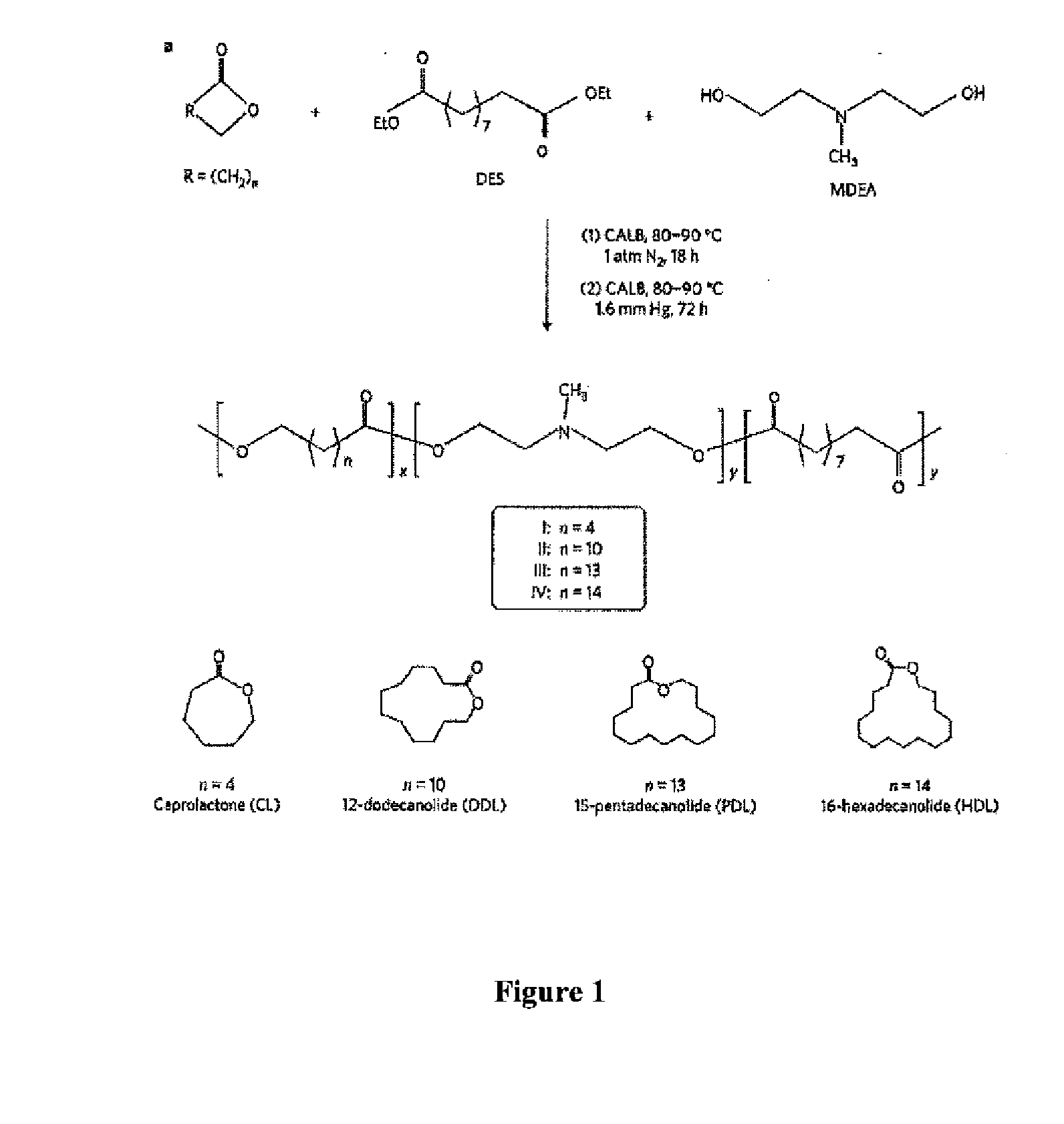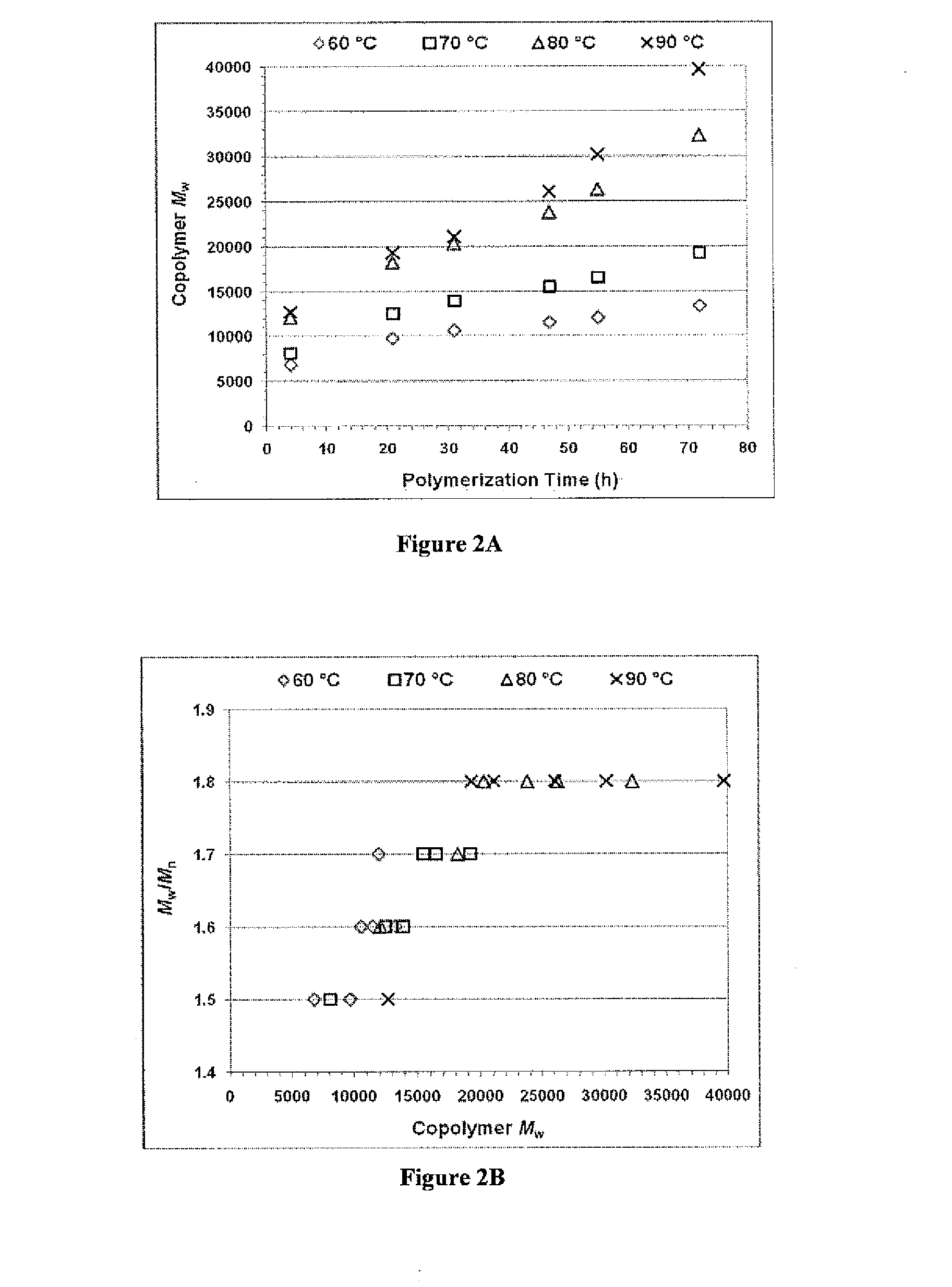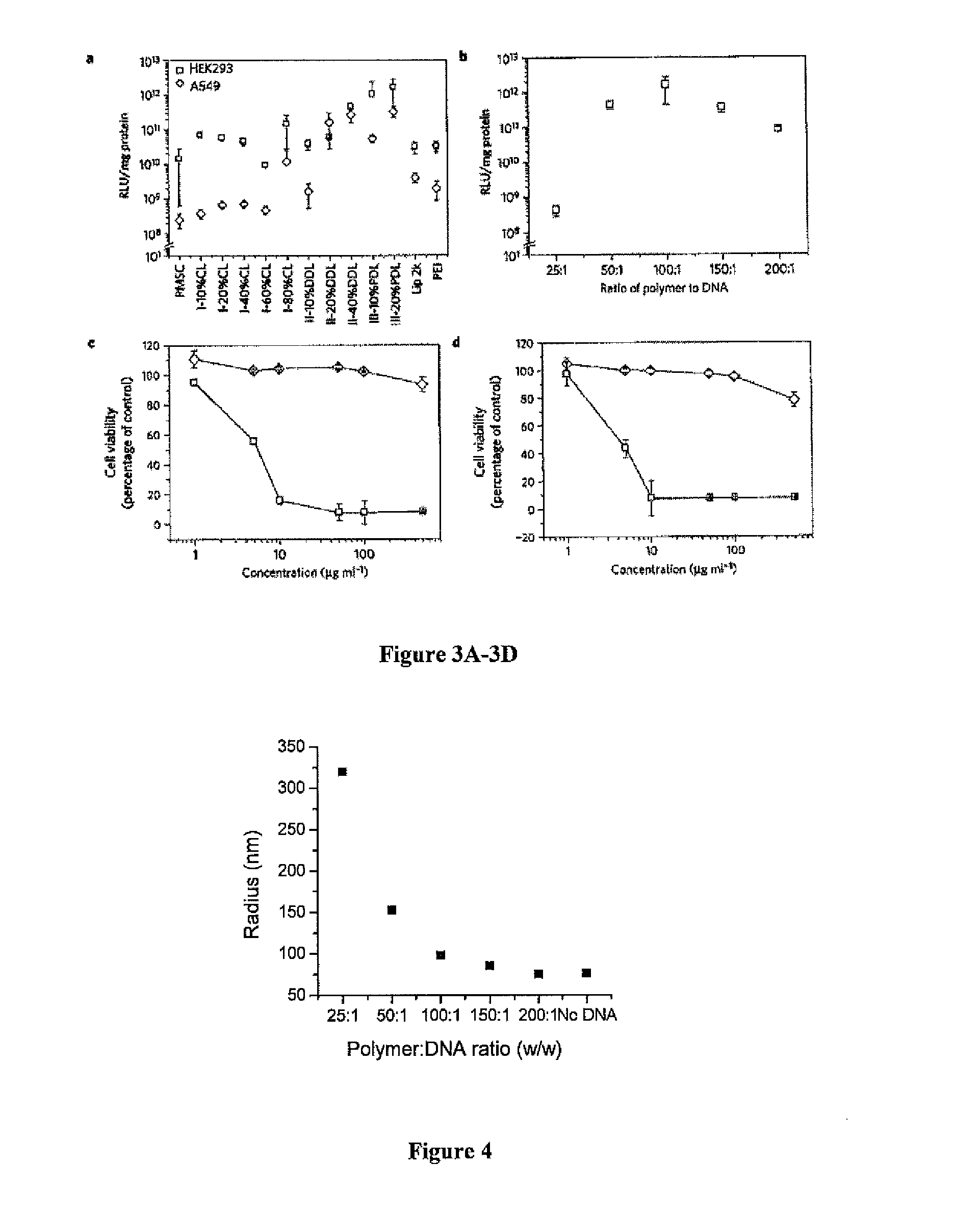Enzymatic synthesis of poly(amine-co-esters) and methods of use thereof for gene delivery
a technology of aminecoesters and aminecoesters, which is applied in the field of enzymatic synthesis of poly (aminecoesters) and methods of use thereof for gene delivery, can solve the problems of complex breakage or aggregate, many cationic, and substantial toxicities, and achieves high efficiency in vitro, effective delivery of genetic materials, and the effect of being suitable for in vivo delivery
- Summary
- Abstract
- Description
- Claims
- Application Information
AI Technical Summary
Benefits of technology
Problems solved by technology
Method used
Image
Examples
example 1
Synthesis and Characterization of poly(amine-co-ester) Terpolymers
[0404]Materials and Methods
[0405]Materials
[0406]ε-Caprolactone (CL, 99%), 12-dodecanolide (DDL, 98%), ω-pentadecalactone (PDL, 98%), 16-hexadecanolide (HDL, 97%), diethyl sebacate (DES, 98%), N-methyldiethanolamine (MDEA, 99+%), N-phenyldiethanolamine (PDEA, 97%), and diphenyl ether (99%) were purchased from Aldrich Chemical Co. and were used as received. Chloroform (HPLC grade), dichloromethane (99+%), hexane (97+%), methanol (98%), and chloroform-d were also obtained from Aldrich Chemical Co.
[0407]Immobilized Candida antarctica lipase B (CALB) supported on acrylic resin or Novozym 435 (Aldrich Chemical) dried at 50° C. under 2.0 mmHg for 20 h prior to use.
[0408]Synthesis and Purification of Lactone-DES-MDEA Terpolymers
[0409]The copolymerization of a lactone with a diacid or diester (e.g., diethyl sebacate (DES)), and a dialkyl amine (e.g., N-methyldiethanolamine (MDEA)) was performed in diphenyl ether solution using...
example 2
Terpolymers are Effective for Gene Delivery In Vitro
[0451]Materials and Methods
[0452]In Vitro Transfection and Characterization
[0453]Human embryonic kidney 293 (HEK293) cell line and lung cancer cell line A549 were obtained from ATCC (American Type Culture Collection). Cells were grown in DMEM medium (Invitrogen) supplemented with 10% fetal bovine serum (Invitrogen), 100 units / ml penicillin, and 100 μg / ml streptomycin (Invitrogen) in a 37° C. incubator containing 5% CO2. For in vitro transfection, DNA polyplexes with weight ratio of 100:1 were used unless otherwise noted. Polymers were dissolved in DMSO at 25 mg / ml.
[0454]For preparing DNA polyplexes for transfection in 24 well plates, 4 μl of polymer solution (25 mg / ml in DMSO) was first diluted in 50 μl sodium acetate buffer (25 mM, pH=5.2). After brief vortexing, the polymer solution was mixed with the same volume of a DNA solution containing 1 μg DNA and vortexed for additional 10 seconds. The polymer / DNA mixture was incubated at...
example 3
Terpolymers are Effective for Gene Delivery In Vivo
[0460]Materials and Methods
[0461]Preparation of Coated Polyplexes for In Vivo Evaluations
[0462]To prepare polyplexes for in vivo gene delivery, 40 μl polymer solution in DMSO (50 mg / ml) was diluted to 40 μl NaAc buffer. After brief vortexing, the polymer solution was mixed with 80 μl NaAc buffer containing 0.25 mg / ml plasmid DNA, followed by a vigorous vortex for 10 second. Coating polyplexes with peptide polyE-mRGD was conducted 10 min after incubation at room temperature, by adding 40 μl buffer containing peptide at 2.5 mg / ml and allowing further incubation for 5 min. Peptide polyE-mRGD (EEEEEEEEEEEEEEEE-GGGGGG-RGDK (SEQ ID NO:1)) was synthesized at the W.M. Keck Facility at Yale University. Immediately before injection, another 40 μl buffer containing 30% glucose was added. Two hundred microliter of the resulted mixture was then injected through tail vein of each mouse.
[0463]To test the effect of serum of polyplex surface change,...
PUM
| Property | Measurement | Unit |
|---|---|---|
| Mass | aaaaa | aaaaa |
| Mass | aaaaa | aaaaa |
| Mass | aaaaa | aaaaa |
Abstract
Description
Claims
Application Information
 Login to View More
Login to View More - R&D
- Intellectual Property
- Life Sciences
- Materials
- Tech Scout
- Unparalleled Data Quality
- Higher Quality Content
- 60% Fewer Hallucinations
Browse by: Latest US Patents, China's latest patents, Technical Efficacy Thesaurus, Application Domain, Technology Topic, Popular Technical Reports.
© 2025 PatSnap. All rights reserved.Legal|Privacy policy|Modern Slavery Act Transparency Statement|Sitemap|About US| Contact US: help@patsnap.com



